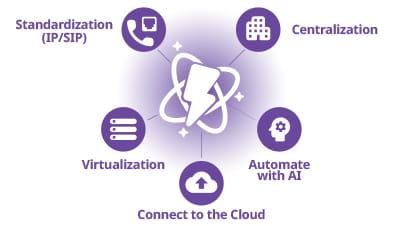A modernized platform empowers enterprises to optimize operations and drive continuous performance.

An opposite force may be at work in the corridors of your company. Discreet but powerful, it slows down your teams, complicates processes and eats into your budget. This disruptive element may be your outdated communications system.
Faced with the pressure to modernize to remain competitive, support hybrid working and meet customer expectations, it's time to ask yourself: do you want to make your communications platform a brake or an accelerator?
The disruptive element: When obsolescence pulls you down
An aging communications system acts like a brake with multiple binding forces. It creates difficulties with its heterogeneous infrastructure, where each remote site has its own system, making maintenance complex and time consuming. Its rigidity prevents you from adapting to new needs, limiting your flexibility. Finally, its financial burden: high maintenance costs and redundant investments drain your resources without adding value.
The transformation: Unleash superpowers!
The good news is that your aged communications system can be transformed into a real superhero for your productivity.
Modernizing it doesn't necessarily mean throwing everything away and starting over. Rather, it's a strategic journey to unlock the “superpowers” that may already be present in your communications platform or will be after the modernization.
Here below are five of the most powerful ones.

1.Standardization with IP and SIP: The foundation of modern communications
The migration to Internet Protocol and Session Initiation Protocol for Voice over IP (VoIP) represents more than a technical upgrade. It's a fundamental shift that unlocks significant financial and operational benefits.
By adopting these standards, organizations can unify voice and data communications on a single optimized network. In addition, they gain seamless interoperability between devices and systems, eliminate duplicate infrastructure investments and position themselves to leverage emerging cloud-based services.
The technology facilitates business continuity and remote work capabilities while enabling smooth international expansion, which has critical advantages in today's distributed workforce environment.
2.Centralization: Streamlining multi-site operations
Rather than maintaining separate communications systems at each site, centralization consolidates management onto a single platform, leveraging IP network reliability to serve remote locations from a central hub. For organizations with geographically dispersed locations, platform centralization delivers dramatic cost reductions and operational simplification.
The business case is compelling. Organizations implementing a centralized communications platform report reducing annual costs by more than five times compared to maintaining distributed satellite systems (see our customer case Departmental Council of Seine-Saint-Denis). Centralization eliminates hardware obsolescence challenges, reduces the complexity of managing technical skills across multiple platforms and locations and provides greater flexibility to adapt to evolving business needs.
3.Virtualization: Optimizing hardware resources
Virtualization represents a downsizing revolution that's reshaping enterprise IT infrastructure. It allows multiple software applications to run on a single physical server, optimizing hardware resources and space needed while reducing power consumption, cooling requirements and maintenance costs.
Virtualization lowers hardware maintenance contracts, reduces risks related to supply disruptions and obsolescence, and simplifies outsourcing to service providers for virtual machine hosting. The technology independence allows organizations to choose the most cost-effective server platforms on the market rather than being locked into proprietary hardware.
Additionally, by modernizing your communications platform you ensure that all its components can support virtualization and are compatible with the main hypervisors on the market, giving you choice and flexibility.
4.Connect to the Cloud: Extending capabilities through hybrid architecture
By connecting the on premises communications platform to cloud-based services, organizations extend their capabilities without disrupting existing systems. The hybrid model enables full mobility for users across any device, delivers omnichannel customer service capabilities and simplifies platform management through cloud-based administration tools.
Companies leveraging this approach can test new applications before full engagement, accommodate seasonal demand peaks and extend to new geographies as they grow — all without major capital investments.
5.Automation and Artificial Intelligence (AI): Reducing operational costs while increasing the service level
AI and automation represent the frontier of communications transformation, delivering both immediate cost savings and long-term competitive advantages. AI-powered automation reduces repetitive management tasks, enables end-user self-provisioning and improves customer service through intelligent chatbots and voicebots handling routine inquiries.
Beyond human interactions, AI enables sophisticated integration with IoT devices for automated alerts, real-time notifications, and proactive system management. These capabilities reduce total cost of ownership while improving service quality and customer satisfaction — creating a virtuous cycle of efficiency and engagement.
Ultimately, modernizing your communications platform means choosing to turn a brake into your most efficient accelerator!
While these five transformation options present compelling business cases, the path to transformation is unique to each organization. Successful modernization requires expert guidance from the manufacturer or their experienced reseller partners who understand both the technical complexities and the business implications of communications transformation. Regardless of the modernization path chosen, the end of the road must be the same: increased efficiency, reduced costs and renewed agility.
Contact us now to discuss where to start based on your unique needs!
Learn more about how to unlock the superpowers of your communications platform.
Latest Blogs

The SaaS Advantage for Hotels and Hospitality Communication…
Modern hospitality communications platforms deliver flexibility, cost optimization and exceptional guest experiences.

Your Communications System: A Brake or an Accelerator?
A modernized platform empowers enterprises to optimize operations and drive continuous performance.

Smart Manufacturing Solutions: The Future of Connected Fact…
Smart manufacturing solutions enable connected factories through reliable, intelligent network connectivity that powers automation and efficiency.

Improving Collaboration in Multimodal Transport
Rainbow transforms how companies, staff and passengers operate and connect in public multimodal transport systems.





